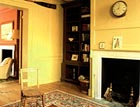Renovating interiors: restoring panelling
Panelling looks fantastic, says William Palin; just remember that fitting it requires specialist skills.


Francis Bacon once said that music sounded better in a panelled room. So when I bought my near-derelict house in Spitalfields, I installed my large collection of cds with a sinking heart, for the panelling had been stripped back to forlorn brick walls by a developer some years before. Only a few decrepit sections of cornice remained. My decision to reinstate the lost panelling made me realise how little panelling (which I now feel to be the crowning glory of the Georgian domestic interior) has been studied. There is not much in the way of published material to help guide this type of restoration and, for information, I relied almost entirely on craftsmen who had worked on similar interiors and who understood the pattern and rationale behind the fitted interior of a 1717 London house. Most panelled interiors conform to a hierarchy, based on the classical column?with the cornice representing the capital; the panel below, the shaft; and the dado rail, the plinth. Once this is understood, the architectural importance of a panelled interior becomes clear. The Spitalfields examples were installed not only to provide a touch of classical elegance for the aspiring merchant classes who originally occupied the houses, but to make sense of the internal spaces. A simple square-edged panel is used for lesser rooms, a rounded or ovolo moulding for the more important spaces, and raised-and-fielded panels for the very best rooms. Judging from old photographs, my relatively modest house had just the two former types, with the ovolo moulding used only in the grandest room. This hierarchy exists, in varying degrees, in all panelled town houses of this date, a result of the use of pattern books by Georgian builders. Panelling of this date was made from ordinary deal pine, of a quality that is extremely difficult to find today, this type of wood being timber from naturally grown, mature trees. Finding decent replacement timber that does not warp and crack can be difficult. The wood for my dining room was reclaimed timber and, in the other rooms, I used a relatively new but excellent innovation: laminated pine, which is made from 2in glued strips, and which reacts to temperature in the same way as old panels. Do not, under any circumstances, be tempted to use MDF; it has no grain and will look dead and artificial when painted. I employed a conservation architect to lay out the elevations of the room and a succession of joiners to carry out the work. It is a highly specialised job?the panels, for example, must be fitted loose to allow for shrinkage, which can be up to 15% in a centrally heated house. Panelling is an immensely civilising feature; it adds a simple, classical grandeur and a wonderful sense of atmosphere, which is even better by candlelight. The only problem, of course, is living up to it?and finding a hiding-place for the television. Mr Palin used joiners Bogdan Majkowski (07961 430358) and Dave Thompson (020?7377 5627) to fit his panelling, which was designed by Jim Howett (020?7375 2757). The Georgian Group (020?7529 8920) and Society for the Protection of Ancient Buildings (020?7377 1644) can help by providing lists of specialist craftsman, architects and suppliers.
Sign up for the Country Life Newsletter
Exquisite houses, the beauty of Nature, and how to get the most from your life, straight to your inbox.
Country Life is unlike any other magazine: the only glossy weekly on the newsstand and the only magazine that has been guest-edited by HRH The King not once, but twice. It is a celebration of modern rural life and all its diverse joys and pleasures — that was first published in Queen Victoria's Diamond Jubilee year. Our eclectic mixture of witty and informative content — from the most up-to-date property news and commentary and a coveted glimpse inside some of the UK's best houses and gardens, to gardening, the arts and interior design, written by experts in their field — still cannot be found in print or online, anywhere else.
-
 Vertigo at Victoria Falls, a sunset surrounded by lions and swimming in the Nile: A journey from Cape Town to Cairo
Vertigo at Victoria Falls, a sunset surrounded by lions and swimming in the Nile: A journey from Cape Town to CairoWhy do we travel and who inspires us to do so? Chris Wallace went in search of answers on his own epic journey the length of Africa.
By Christopher Wallace
-
 A gorgeous Scottish cottage with contemporary interiors on the bonny banks of the River Tay
A gorgeous Scottish cottage with contemporary interiors on the bonny banks of the River TayCarnliath on the edge of Strathtay is a delightful family home set in sensational scenery.
By James Fisher